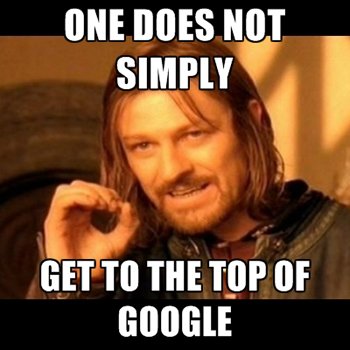What Does Machine Learning & Artificial Intelligence Mean For SEO?
Google and other search engines use machine learning and artificial intelligence to present a user with the most relevant search. How does this affect SEO in the future?
You may have asked yourself at a time, “How does Google’s search algorithm work? Why is my website not ranking?” Well, you’re right there with thousands of other businesses that have been stumped by the search engine giant. How and why Google works the way it does are important questions to ask yourself when trying to rank your website. It’s crucial to keep in mind that SEO isn’t just a bunch of fairy dust. It’s also not simple. There are many essential elements to take into account when trying to rank your website. Just remember it’s not an overnight process.

A Simpler Time for SEO
Let’s take a step back about five to ten years. An archaic time for SEO and internet marketing. The term “internet marketer” back in 2005 was almost derogatorily segregating a clique of spammers, phishers, and anybody who wanted to shove a product in your face online. Here’s the kicker, it worked. Many people could rank their site within days simply by spamming, keyword stuffing, and building completely irrelevant backlinks.
The Downfall of “Black-Hat” Techniques
Moving to 2012, Google decided to make semantic search more relevant and announced the use of AI & ML. This means no more spam content, no more links that were unrelated to your website, no more ghost pages & island pages on your site, and the downfall of keyword stuffing, metadata manipulation, and irrelevant traffic manipulation.
How Google’s Algorithm Works Now
Google’s search algorithm is broken down into many components. This is the only way Google can stay on top of the web’s 60 Trillion+ individual web pages. Google uses artificial intelligence to discover elements that, in a way, create a flow of ranking factors. So how can we really understand how Google decides to rank a website? We start with Crawling & Indexing…
Understanding How Google Works to Perspicaciously Optimize Your Website
-
Crawling & Indexing
Google navigates the web by crawling – This means following internal website links from page to page. As a site owner or webmaster, you can choose which pages you want Google to crawl, or you can deindex your entire site with robots.txt if you wish. Google uses their bot (Googlebot) to sort pages by content, links, anchor text, and more.
-
Formulas & Algorithms
This is where it gets interesting. Google writes programs and formulas to deliver the best search results possible to the user. Algorithms work by looking for clues to understand relevantly what it is that you’re searching for, then they use these components to pull relevant results from the index.
-
Ranking
After Google has used crawling, formulas, and algorithms, they decide how to rank a website. Now, Google has an unknown amount of ranking factors for a website, but we know it’s pretty high. I can most likely list over 250 of them. All of these also have their own factors within. For the sake of your sanity, I’m only going to mention the top 5 ranking factors. These are open to interpretation as well.
1. Backlinks & Social Signals
I realize that “backlinks” is a very broad factor. There have also been debates about backlinks losing their value. Though, we have seen time and time again that a website with a great link profile and the authority of sites linking to them, seem to take precedent in rankings. This means that you need to build backlinks at a natural pace that are also relevant to your site in some way. If you are a company that sells cats, and your content on your website is all about cats, you probably shouldn’t have a backlink from a website that is all about dogs. Google will not see that as relevant to your company, and like discount the link or possibly penalize you for it (if there are enough bad links). This is part of Google’s AI process to decipher content, photos, and more. Social signals are also very important for Google to see that users are engaging in your brand.
More backlink factors:
- Relevance
- Variety & Unnatural Building
- Authority (DA/PA of linking site)
- IP & Subnet Diversification
- Loss of Backlinks
2. Content
You may often hear the phrase “content is king” when it comes to SEO & Digital Marketing. And as previously stated, ranking elements have factors of their own associated with them. “Content” doesn’t just mean throw 500 words on a page with a picture. Google also now uses keyword phrases, frequency, and relevance to determine the quality of your content. This doesn’t mean length isn’t important though.
More Content factors:
- Internal Linking
- Users Commenting & Interaction
- Duplicate Content
- Auto-Generated Content
- Content Updates
3. Anchor Text Profile
Anchor text is the text that creates a hyperlink. You most likely use this often when creating your backlinks (even if it’s accidental). The anchor text you use when creating backlinks is a critical part of linking. Google also uses this to determine what keywords you are trying to optimize for.
More Anchor Text factors:
- Keyword Diversity
- Users Commenting & Interaction
- Duplicate Content
- Auto-Generated Content
- Content Updates
4. Onsite SEO
Onsite is an important part of your SEO strategy. The simplest explanation of onsite is optimizing for your keyword. This consists of title tags, metadata, H1 tags, and more. It’s also important to understand why you are optimizing that title for your keyword, and how to generate it in a way that gives a positive user experience. If your keyword is “credit repair”, you wouldn’t want to just have your title tag as “Credit Repair Company”. You want to give Google and your users an explanation of your business onsite.
More Onsite SEO factors:
- Friendly URL’s
- Number of Pages
- Keyword Frequency In Content
- Image Optimization (Alt & Title)
- Over Optimization
5. Technical SEO
Using technical SEO to show Google who you are, and what your business offers is also very important. This is done by optimizing for broken links, HTTP status code errors, schema & microdata mark-up, mobile-friendly, page speed load time, and more. The technical side of SEO is more for search engines than your users. This lets search engines know that your site is “complete” for lack of a better word. Learning the basics of Google’s Search Console will help you with a lot of this side of things.
More Technical SEO factors:
- Robots.txt file
- XML Sitemap
- Domain History & Status
- Breadcrumbs & Sitelinks
- Code optimization
Now that we understand a little better how Google works, we can determine what about our site is initiating or devastating your overall rankings. The next step would be understanding how users view your site, as well as Google, to give the best possible experience for both search engines and users. Google is determined to give the best possible result to the user. This is how Google uses neural networks to attempt to ascertain what a user wants to see.
How does Google use machine learning to calculate the best search result?
This is a great question to ask ourselves. Understanding how Google uses these methods can help us decide what we have to do to (hopefully) rank for our keyword. Many search engines use these methodologies for their algorithms. They use machine learning and artificial intelligence for pattern detection in many ways to understand what the user is searching for.
It may help to understand how neural networks work, and how computers learn things. The flow of information in an Artificial Neural Network (ANN), works in two ways which are similar to an organic brain.
When it is being trained, informational patterns are fueled into the network by input units. This triggers layers of concealed units which in turn reach the output units. For an artificial network to learn, an element of feedback must be involved similar to how our children learn between right and wrong by their parents.
So how does Google use this process of feedback and backpropagation for search? There are many ways Google can use this process to antiquate previous search techniques to reveal a better system for their users.
Most importantly is how the user correlation between multiple variables to predict the outcome of future results. ANN’s are fed scripts that can be used to supervise learning on past outcomes to hypothesize a prediction. Combining variables is also important mathematically.
There must be a distinction between multiple variables to provide an outcome. Decision learning works easiest with the least amount of possible outcomes. Outcomes are predicted by layers. If you want to learn a bit more about the technical side of things, please watch this video by Stanford. Google tells us that they use 4 main layers in their machine learning process (cited from observer.com):
- Speech Recognition – Google has developed and officially launched a new system that uses a multi-layered deep learning neural network to cut down on errors by 25 percent. The whole area has still seen a hand-engineered approach to structure that looks for nouns, verbs, something to indicate it’s a question, etc., but Google is still working on developing a more sophisticated approach to natural language.
- Natural Language & Search – If you think about a Google search, you type words or phrases and get back relevant results. It seems simple. However, machines have always just matched keywords; when you type, “how to change a tire,” it looks for results with that phrase or synonyms like “repair.” Researchers are now trying to advance machines to actually understand natural human language instead of approach it like “a bag of words.” This will help machines generate answers to more complex questions like, “What’s a school near me that would be good for my daughter with special needs?”
- Sentence & Shape Translation – Every single sentence has a completely unique shape, and similar sentences have similar shapes. For example, the shapes of the following two sentences would be extremely close: “I’d like to change my tire.” “I want to repair my tire.” Identical sentences expressed in different languages have identical shapes. So, once a machine knows the shape of a sentence in one language, it can use that to look for the same shape in any other to get the translation.
- Imagine Captioning – They’ve trained a neural network to recognize images very well by feeding it good examples. The image is the input and the caption is the output, and the more images they feed it, the better the captions become.
Google has also given us access to its Prediction API. The Prediction API provides pattern-matching and machine learning capabilities. Given a set of data examples to train against, you can create applications that can perform the following tasks:
- Given a user’s past viewing habits, predict what other movies or products a user might like.
- Categorize emails as spam or non-spam.
- Analyze posted comments about your product to determine whether they have a positive or negative tone.
- Guess how much a user might spend on a given day, given his spending history.
To learn more about how machine learning works for search engines, please read Google’s research publications.
How does Machine Learning & AI affect SEO?
I think one of the most important questions to ask here is this: Does machine learning and artificial intelligence effect SEO in a negative or positive way? My philosophy on this may be different than other people in the SEO world, but personally, I believe this helps us. If you are using White-Hat SEO techniques, you shouldn’t have any reason that you’re not ranking on Google. Optimizing onsite and generating great, sharable, user-engaging content is what Google really wants to see. The rest should not be manipulated. It may take you a while to rank, but let it come naturally. This is what will help ensure your ranking to be static in Google. Remember, Google doesn’t like Spam!

The only specific negative I see in this is that eventually, Google’s algorithm may grow at a pace that even Google developers cannot keep up with what it is doing. At this point, we would have to work on generating experiments as to what ranking factors truly matter to Google’s brain. We may eventually find that SEO & site optimization is much more difficult than we could anticipate. This also means that it could become easier. In my opinion, it’s easier to give users exactly what they’re looking for than to give search engines exactly what they’re looking for. If you have great content and a great user experience, I wouldn’t worry as much about what Google wants. Your customers will be happy! And well, customers being happy is never a bad thing.

Matthew is the President of Infront Webworks and is a New England native now calling Colorado Springs home. Matt attended The University of NH where he pursued a BS in Natural Resource Economics & Business Administration. Aside from Infront; Matthew has owned and managed two other online agencies based on the seacoast of New Hampshire and been a key player in multiple technology mergers & acquisitions. When he’s not bathing in technology, online marketing & business; he’s probably spending time with his wife and daughter, boating, skiing the trees, hiking or cooking..he is a foodie for sure!



